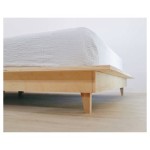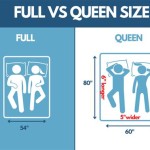What Are The Standard Dimensions Of A Full-Size Bed?
Understanding the dimensions of a full-size bed, also known as a double bed, is crucial when making decisions about bedroom furniture, mattress purchases, and bedroom layout. The full-size bed offers more sleeping space than a twin bed, making it a popular choice for single adults and teenagers. Its dimensions provide a balance between available space and sleeping comfort. This article will explore the standard dimensions of a full-size bed, explain the variations that may exist, and discuss the factors influencing the choice of a full-size bed.
The standard dimensions of a full-size bed are typically 54 inches wide and 75 inches long. These measurements refer to the mattress size; the overall dimensions of the bed frame may vary slightly depending on the style and design. The standardized dimensions allow for consistent manufacturing of mattresses and bedding, making it easier for consumers to find compatible products.
The width of 54 inches provides ample space for a single sleeper to move comfortably during the night. The length of 75 inches is generally suitable for individuals up to approximately 5'10" in height. Taller individuals might find a full-size bed slightly cramped, particularly if they tend to stretch out while sleeping. In such cases, considering a queen-size or king-size bed may be a more appropriate option.
Understanding Standard Dimensions and Tolerances
While the dimensions of a full-size bed are commonly cited as 54 inches by 75 inches, there may be slight variations within the manufacturing process. These variations are typically within an acceptable tolerance range, meaning the actual dimensions might be slightly above or below the stated specifications. However, reputable manufacturers adhere to strict quality control measures to minimize these discrepancies and ensure consistent sizing.
When purchasing a mattress or bed frame, it is always advisable to check the specific dimensions provided by the manufacturer. This ensures a proper fit and avoids issues such as a mattress being too large or too small for the bed frame. It is important to note that imported mattresses or bed frames may have dimensions that deviate slightly from the standard US sizes.
The height of a full-size bed, from the floor to the top of the mattress, can also vary significantly depending on the bed frame and mattress thickness. Platform beds, for example, typically sit lower to the ground, while beds with box springs or foundations will be higher. The desired bed height is a matter of personal preference, but it is important to consider accessibility and ease of getting in and out of bed.
Bed frames add additional dimensions to the mattress size. The frame's design can increase the overall footprint of the bed by several inches on each side and at the headboard and footboard. Before purchasing a bed frame, measure the available space in the bedroom carefully to ensure that the assembled bed will fit comfortably without obstructing doorways or furniture.
Consider the type of bedding used on a full-size bed. Fitted sheets, flat sheets, and comforters are manufactured to correspond to the standard dimensions of the bed. Purchasing bedding specifically designed for a full-size bed ensures a proper fit and prevents issues such as sheets being too tight or too loose. Standard-sized pillows also complement the full-size bed, providing adequate support for comfortable sleep.
The choice of a full-size bed often depends on the size of the bedroom. In smaller rooms, a full-size bed provides a reasonable sleeping surface without taking up too much floor space. This allows for adequate room to move around and accommodate other essential furniture items, such as dressers, nightstands, and desks. In larger bedrooms, a queen-size or king-size bed may be preferred to create a more spacious and luxurious feel.
A full-size bed can also be a practical choice for guest rooms. It offers more sleeping space than a twin bed, making it comfortable for single adults or couples visiting for short periods. The versatility of the full-size bed makes it a popular choice for various sleeping arrangements and room sizes.
Factors Influencing The Choice of a Full-Size Bed
Several factors influence the choice of a full-size bed, including room size, sleeping habits, and budget. Room size is a primary consideration, as a full-size bed can be a space-saving option compared to larger beds. Sleeping habits also play a role, as individuals who sleep alone and do not require a large amount of space may find a full-size bed perfectly adequate. Budget is another important factor, as full-size mattresses and bed frames are generally less expensive than their queen-size or king-size counterparts.
The sleeper’s size and height also influence the decision. Taller individuals may feel more comfortable with a longer bed, such as a queen-size or king-size. Couples typically require more sleeping space and often opt for larger beds to avoid disturbing each other during the night. Individual preferences for sleeping positions and the amount of space needed to move comfortably can also impact the decision.
The overall design and style of the bedroom can also influence the choice of a full-size bed. Some individuals prefer a minimalist aesthetic and may choose a smaller bed to create a sense of openness and simplicity. Others may prioritize comfort and luxury and opt for a larger bed to create a more opulent and inviting atmosphere. The choice of bed size should complement the overall design and create a harmonious and balanced space.
Consider the long-term needs when choosing a full-size bed. If there is a possibility of sharing the bed in the future, such as moving in with a partner or having children, a larger bed may be a more practical investment. However, if the bed is primarily for a single individual and space is a constraint, a full-size bed can be an excellent choice. Evaluating future needs ensures that the chosen bed size remains suitable over time.
The type of mattress chosen for a full-size bed can also affect comfort and sleep quality. Mattresses are available in various materials, including memory foam, innerspring, latex, and hybrid models. Each type of mattress offers different levels of support, firmness, and temperature regulation. Choosing a mattress that suits individual sleeping preferences and needs is essential for achieving restful and rejuvenating sleep. Consider factors such as back pain, allergies, and temperature sensitivity when selecting a mattress.
Accessories such as mattress toppers and protectors can also enhance the comfort and longevity of a full-size mattress. Mattress toppers can add an extra layer of cushioning and support, while mattress protectors can shield the mattress from spills, stains, and allergens. These accessories can improve the overall sleep experience and help to maintain the mattress in good condition for longer.
Variations and Considerations for Bed Frames
While mattresses adhere to standard dimensions, bed frames can vary in size and design. The frame's style, including the headboard, footboard, and side rails, will affect the overall dimensions. Platform beds, which eliminate the need for a box spring, often have a lower profile and can save space. Beds with elaborate headboards or footboards may take up more room and require careful consideration of the bedroom's layout.
When choosing a bed frame, ensure that it is compatible with the dimensions of the full-size mattress. A frame that is too small will not properly support the mattress, while a frame that is too large can create an unstable and unsafe sleeping surface. Check the manufacturer's specifications to ensure that the frame is designed to accommodate a standard full-size mattress. Some bed frames come with adjustable slats or supports that can be customized to fit different mattress thicknesses.
The material of the bed frame can also influence its durability and aesthetic appeal. Bed frames are available in various materials, including wood, metal, and upholstered options. Wooden frames offer a classic and timeless look, while metal frames are often more durable and lightweight. Upholstered frames can add a touch of luxury and comfort to the bedroom. Consider the overall style of the bedroom and choose a bed frame material that complements the existing décor.
Some bed frames come with built-in storage options, such as drawers or shelves. These storage features can be particularly useful in smaller bedrooms where space is limited. Storage beds can provide additional space for storing clothing, bedding, and other items, helping to keep the bedroom tidy and organized. When choosing a storage bed, ensure that the drawers or shelves are easy to access and do not interfere with the surrounding furniture.
The assembly of a bed frame is another important consideration. Some bed frames require extensive assembly, while others are easier to put together. Consider the level of assembly required and choose a frame that you are comfortable assembling yourself. If you prefer to avoid the hassle of assembly, you can hire a professional to assemble the bed frame for you.
Finally, consider the warranty offered by the manufacturer on both the mattress and the bed frame. A warranty provides protection against defects and ensures that you can receive a replacement or repair if any issues arise. Read the warranty terms and conditions carefully to understand the coverage and limitations. A comprehensive warranty can provide peace of mind and ensure that your investment is protected.

Mattress Sizes Chart Bed Dimensions Guide Purple

Full Size Mattress Dimensions How Big Is A Bed

The Official Organic Mattress Size Guide 2025 Edition

Mattress Sizes And Dimensions Guide To See More Read It
Mattress Size Chart And Bed Dimensions Guide 2024

Bed Sizes And Space Around The

Comprehensive Guide To Bed Sizes And Dimensions

Ultimate Guide To Bed Size Dimensions Find The Perfect Fit

Bed Sheet Sizes And Dimensions Guide Standard Oversized Sheets

A Guide To Mattress Sizes And Dimensions Charts








